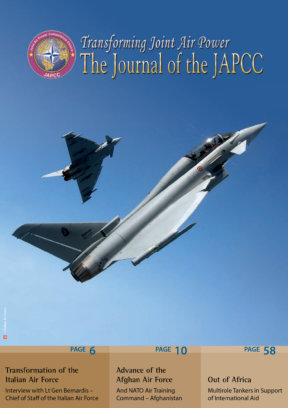Editorial
“… after 30-plus years of serving in many different organizations, both parochial and multinational, I personally can say unequivocally that there is no organization who could have accomplished what we have been able to achieve except for NATO.”
Lt Gen William Caldwell, commander NATO Training Mission – Afghanistan in a press briefing on Afghan National Security Force development – 23 Feb 2011
We begin the thirteenth edition of the JAPCC Journal with two contrasting articles. The first looks at one of the world’s oldest Air Forces and the second at its youngest. Few need reminding of the genesis of Air Warfare during the Italo-Turkish War in 1911, where reconnaissance and bombing sorties by the Servizio Aeronautico represented the first ever use of heavier-than-air aircraft in armed conflict. Air Power has come a very long way since then and we are indebted to the Chief of the Italian Air Force for his insights into today’s challenges.
We then turn to Afghanistan. As a first principle of counter-insurgency, those who help must appreciate that they cannot ultimately win another nation’s internal war for them. The threatened nation must eventually field its own forces, develop its own strategy, and find its own political solution to defeat the insurgency. Thus the central focus of any COIN strategy should be on the development of capable indigenous forces; yet we prefer to view operations as the main effort and the training and equipping of such forces as a secondary mission. One need only look to the American experience in Greece in the 1940s, The Philippines in the ‘50s, Laos in the ‘60s and El Salvador in the ‘80s to understand the importance of developing indigenous forces as a strand of COIN strategy. Recent experience from Iraq and Afghanistan indicates that we may not be applying this lesson with sufficient rigour. In his article Gp Capt Adrian Hill describes how the growth of a professional, fully independent, operationally capable and sustainable Afghan Air Force is key to successful transition in Afghanistan.
I am particularly grateful to MDA and Astrium for their fascinating articles on Contracted UAS in Afghanistan and Spatial GEO information. Partnership with industry is crucial to JAPCC success and these articles are further evidence of this strong relationship.
Elsewhere in this edition we take a look at the challenges of using Space effectively in contemporary operations and at the wider issue of the Global Space Commons. We learn about the SACT post-Lisbon Action Plan, cover Air-Land Integration, examine Canadian Air Power in Afghanistan, explore Airlift initiatives and take a fresh look at Air-to-Air Refuelling. We also have the second part of Wg Cdr Tony Stansby’s analysis of Military History.
Paddy Teakle
Air Commodore, UK AF
Assistant Director Transformation, JAPCC









